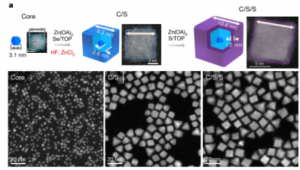It seems I’ve written a lot recently about EL-QLED progress, even though commercialization would appear to be still many years off. But it is just so interesting I can’t help myself! You may recall I lamented about the status of blue EL-QLED (electroluminescent QLED) earlier this year in Singing the EL-QLED Blues. A recent article in Nature by the team at SAIT has demonstrated some phenomenal progress in blue EL-QLED which has me a little less melancholy. Add to this Nanosys’ reported progress in green EL-QLED at SID Display Week 2020, and the outlook could be described as… promising.

First let me set the stage. Progress in EL-QLED has been consistently slow for Cd-free EL-QLED, particularly in terms of stability under operating conditions. Samsung’s own Changhee Lee presented a brief historical summary last month at SPIE Optics and Photonics. What is missing from this graph however are two data points that were just recently released (if you are impatient you can scroll down to my revised graphic).
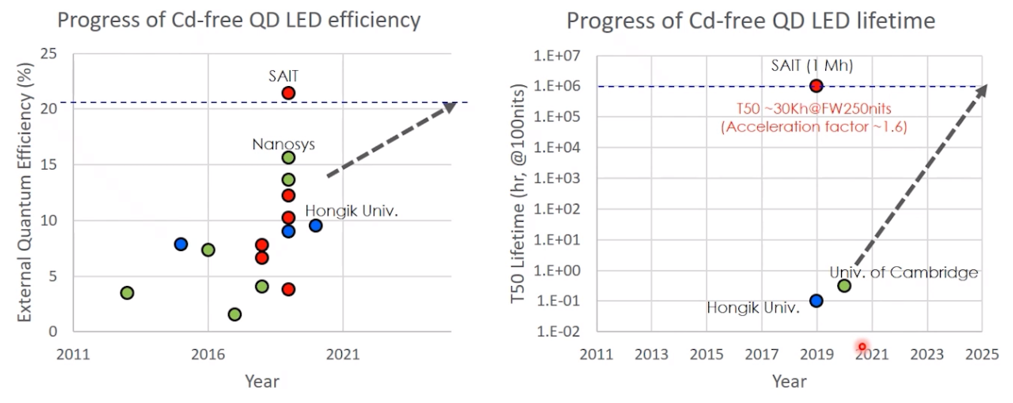 Progress in Cd-free EL-QLED devices. Notice how far behind green and blue remain in lifetime. Source: Samsung, SPIE Optics and Photonics 2020.
Progress in Cd-free EL-QLED devices. Notice how far behind green and blue remain in lifetime. Source: Samsung, SPIE Optics and Photonics 2020.
As you can see, there is (was) still a lot of room for improvement for blue and green. If Cd-containing Quantum Dot (QD) history is any indication of how Cd-free will progress, I would have placed money on green to be the next data point to climb into the realm of commercial viability, and blue to remain far behind. I would have lost that bet.
Summary of the (impressive) properties of Samsung’s blue EL-QLED devices:
- Emission wavelength = 457 nm (FWHM peak width = 36)
- PLQY = 100% (= perfect)
- EQE = (up to) 20.2% (= theoretical max)
- T50 = 15,850 (orders of magnitude better than prior publications)
- Max brightness = >88,000 nits (new record)
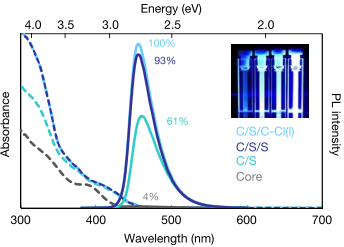 Optical properties of the blue QDs used in the record-breaking EL-QLEDs. Source: Nature 586, 385–389 (2020)
Optical properties of the blue QDs used in the record-breaking EL-QLEDs. Source: Nature 586, 385–389 (2020)
In the Nature paper, Samsung describes the multitude of chemical and processing changes they make in order to achieve these metrics. Highlights include:
- Synthesis of cubic ZnTeSe/ZnSe/ZnS QDs optimized Te content for 457 nm emission
- Reduced imperfections (stacking faults) in QD by treatment with HF and ZnCl2 during shell growth
- Elimination of trap states by treating QDs with ZnCl2 after synthesis (in solution and film form factors)
- Improved charge balance by tuning electronics of the QD bands via treatment with chloride salt
- Double emissive QD layer with different surface treatments
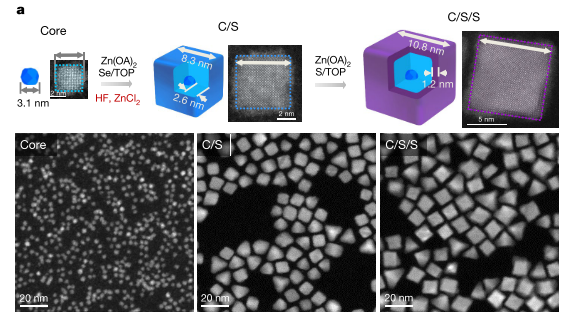 Example of the cubic QDs produced by Samsung. Source: Nature 586, 385–389 (2020)
Example of the cubic QDs produced by Samsung. Source: Nature 586, 385–389 (2020)
Perhaps the most impressive metric is that these new blue EL-QLEDs have superior performance compared to their Cd-containing brethren. That’s something no other color QD can boast.
In order to complete the story, I must provide you with a brief update on Nanosys’ green EL-QLED performance mentioned (in passing) during SID Display Week 2020. Using the same lifetime criteria (T50, 100 nits) they stated 38,000 hr lifetime! An impressive feat indeed, considering only a few years ago these materials were degrading upon intense interrogation with your eyes! For comparison, Nanosys reported blue Cd-free devices with T50 (100 nits) at 350 hours, which to be honest looked prety good a few short weeks ago. But now the bar has been raised.
With these two improvements (blue and green Cd-free EL-QLED), the current technical status looks a lot different than it did a few months ago, which is very exciting. Below you can see an “updated” version of Samsung’s Cd-free EL-QLED progress map. Take note that the y-axis on the lifetime graph is logarithmic scale, and the two new data points as triangles are many orders of magnitude above the old data points. There may be a few data points missing for those of you who pay close attention, but the story remains the same.
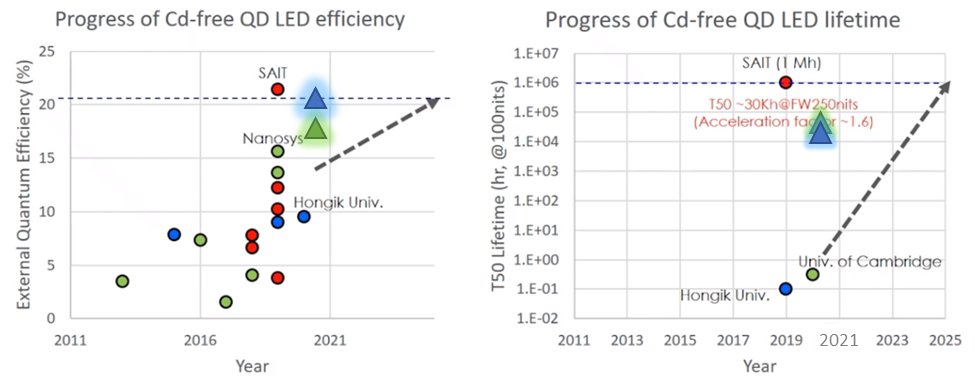 Current status of Cd-Free EL-QLED (Revised version with updated data points discussed herein as highlighted triangles). Original graphic source: Samsung, SPIE Optics and Photonics 2020.
Current status of Cd-Free EL-QLED (Revised version with updated data points discussed herein as highlighted triangles). Original graphic source: Samsung, SPIE Optics and Photonics 2020.
(Deep breath) … Let me bring you (me) back down to reality for a moment, however. Just as Samsung’s earlier paper on red Cd-free EL-QLED devices where they touted 1M hr lifetime, these numbers are only as meaningful as the metrics behind them. 100 nits is simply not sufficient for a commercial display. And lifetimes reported as T50 are only just a starting point that we must live with until devices become too stable to use this metric. As an example, the blue EL-QLEDs reported here showed T50 of only 442 hr at 650 nits. With modern LCD demonstrating 10’s of thousands of hours at >1000 nits, these QLED devices still have a hill to climb. But perhaps it is nearing time to switch to a more meaningful metric like T90. This alone I consider to be a great achievement, and an indication of great things to come. (PP)
Peter Palomaki is the owner and chief scientist at Palomaki Consulting, a firm specializing in helping companies solve big problems at the nanoscale. His utilizes his expertise in quantum dots and materials chemistry to solve challenging problems with clients large and small.

